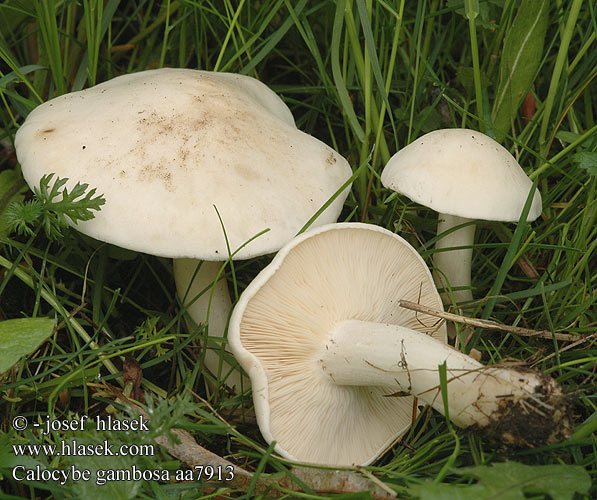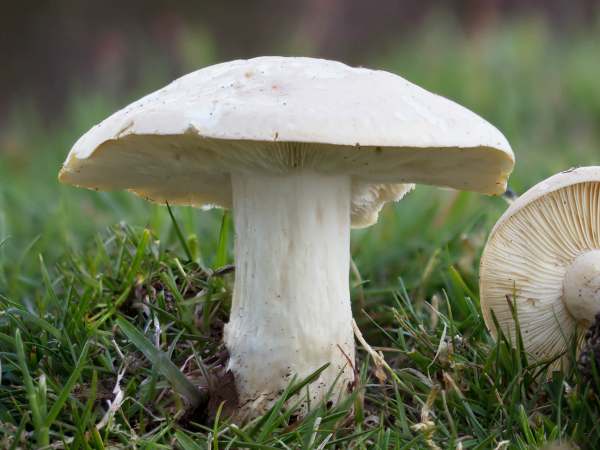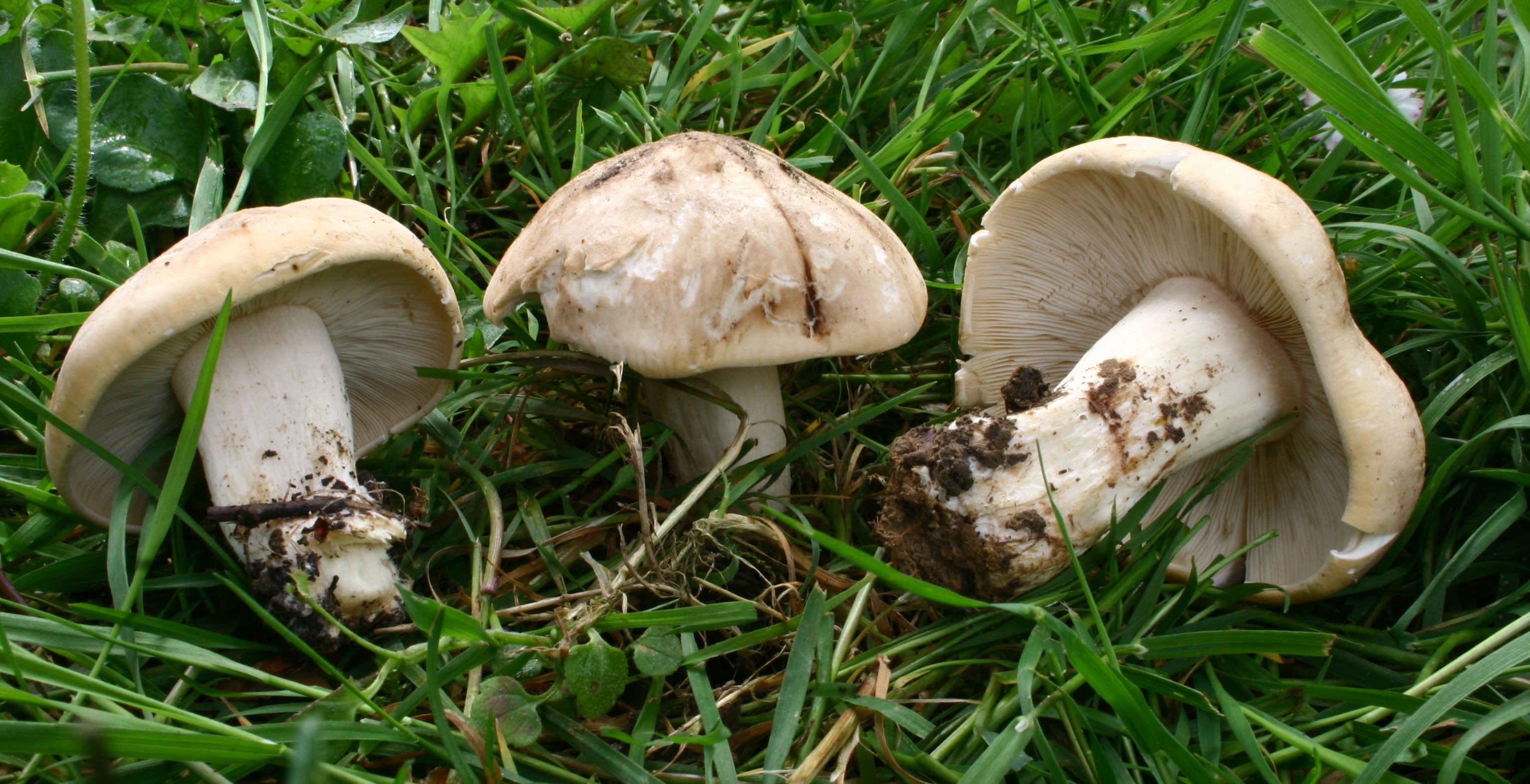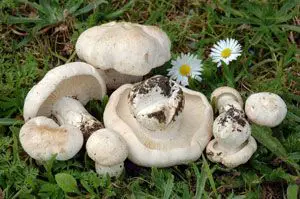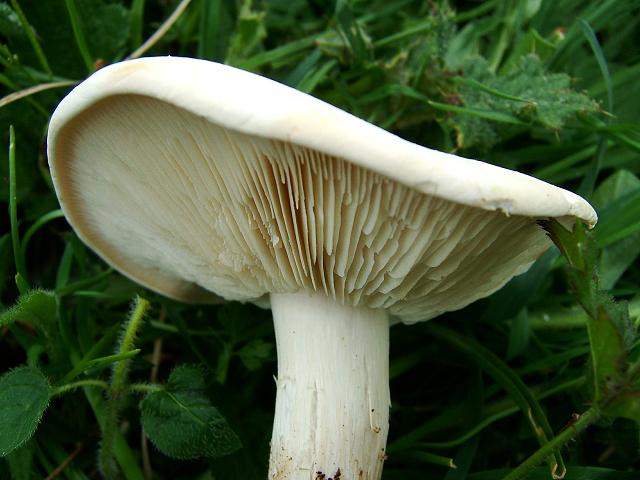Calocybe gambosa
Mairitterling ( Calocybe gambosa )
The May or Georg Ritter Ling ( Calocybe gambosa ), also called Maipilz, is a species of fungus in the genus of beautiful heads. He is considered a good edible mushroom, which, however, with the highly toxic Red brick crack fungus ( Inocybe erubescens ) or the poisonous giant Anthias ( Entoloma sinuatum ) can be confused.
- 6.1 Notes and references
Features
Macroscopic characteristics
The 3-10, rarely up to 15 cm wide hat is hemispherically shaped young, later expanded and often irregularly bent. The matte and dry surface usually shows a white to off- white, with some varieties also yellowish or brownish color. The narrow and crowded stationary blades are straight or bulged grown on a stick. The spore powder is white. The 3-10 cm long and up to 4 cm wide handle has a solid consistency and is colored white. Striking is the intrusive flour-like smell ( such as cucumber or kieniges wood) of the meat.
Microscopic characteristics
The elliptical and smooth-walled spores show no iodine color reaction. Their dimensions are 4-7 × 2-3.5 microns. The basidia, where mature spores have a siderophile granulation. Cystidia however, are completely absent. At the partition walls of the hyphae buckles are usually present. Unlike Raslingen incrusted with hyphae the pigment in the hyphae of the Mairitterlings dissolved intracellularly in the cell sap.
Artabgrenzung
The highly toxic Red brick crack fungus ( Inocybe erubescens ), whose fruiting bodies grow at the same time, is the classic double of Mairitterlings. Strikingly, the reddening flesh radialfaserige hat and the aged dirty brownish fins. Furthermore, the meat of young fruiting bodies sometimes smells pleasantly fruity, older specimens develop later an unpleasant sweetish spermatic odor.
The heat-loving, toxic giant Anthias ( Entoloma sinuatum ) smells on average even after meal, but only forms from August fruiting bodies. Otherwise young specimens can see the Mairitterling similar in plan view quite volatile. The slats are not white but yellowish. At the age, the color changes to a dirty pink by the spore powder.
Ecology
The Mairitterling considered as site- faithful and lives saprob in the soil. Its fruiting bodies grow in clusters or squads, densely populated arc and fairy rings. Depending on the altitude fruktifiziert the fungus from April to July, commonly in two waves: first, from late April to mid-May, then from June to early July. Occasionally should appear in August and September, a few isolated stragglers.
As the habitat agaric prefers sunny, grassy places in beech and beech-fir forests, rare hornbeam - oak forests and deciduous trees and riparian forests. Likewise, resources are occupied in the forest edge companies such as Prunetalia hedges and hazel pioneer crops. In addition, the fungus colonized secondary habitats such as glades, parks and forest road and roadsides. Even before semi-arid grassland or juniper heaths, pastures and orchards Ackerrainen and makes the Maipilz not stop. The same applies to sporadically or moderately fertilized, extensively managed meadows and pastures. In contrast, the type is missing - from isolated finds in non-native spruce and pine reforestation apart - in acidophilous oak, spruce-fir and spruce forests.
Suitable soils are fresh, at best moderately dry to moderately moist and predominantly alkaline to neutral. Much less common selects the Mairitterling moderately acidic or weakly abgesauerte superficial, moderately nutritious and well up abundantly supplied with bases and different subtle floors. These mainly include braunlehm - Rendzinen, Terra fusca, base -rich and sandy to anlehmige brown soils on Kalksanden, gravel and clays, marls, now and then base -rich plutonic rocks. The occurrence of strongly acidic weathering colored and Keuper sandstones, strongly quartz-bearing silicates and peat only founded on gravel forest roads and paths. Sporadically can be found fruiting bodies even after the liming of forest soils.
Dissemination
The Mairitterling is meridionally to boreal widespread in the Holarctic. In North and Central Asia, the kind in the whole of Siberia, Korea and Japan are found. From the North American subcontinent only one Aufsammlung in southwestern Canada exists. From North Africa finds have been reported from Morocco, also in the Canary Islands, the fungus can be found. In southern Europe there find reports from Bulgaria, Italy, Romania and Spain. On the western subcontinent of Mairitterling in the Benelux countries, France, the United Kingdom was northward up to the Shetland Islands and very rarely detected in Ireland. In Central Europe the way from Germany, Lichtenstein, Austria, Poland, Switzerland, Slovakia, Czech Republic and Hungary is known. In Eastern Europe, the fungus in Russia is such as Bashkortostan, and in the Northeast in Estonia at home. The presence in Northern Europe extends from southern to middle Fennoscandia, the discovery of Iceland, however, unsecured. In Germany, the species scattered from the Danish border, Helgoland and the coastal areas of the North and Baltic Seas is common in regional compression and loosening areas until the Upper Rhine and the Northern Alps.
Importance
The Maipilz is a productive edible mushroom that can be collected early in the year and affects hypoglycemic. However, it should be simmered briefly, because the fruit bodies are tough otherwise. The feed value is, however, controversial. The intrusive smell and taste, which also lose in the preparation not quite, can trigger an idiosyncrasy with appropriate disposition.



